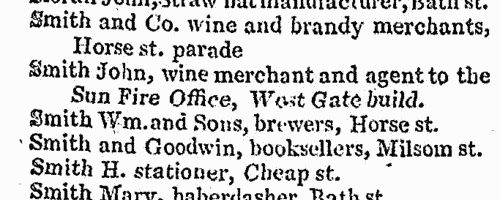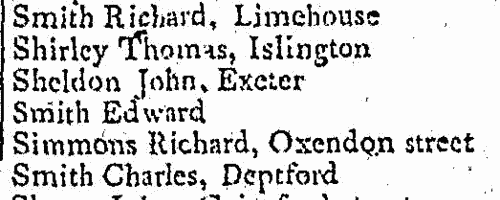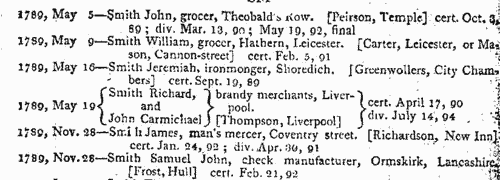Our indexes include entries for the spelling mills. In the period you have requested, we have the following 2,946 records (displaying 1,091 to 1,100):
Inhabitants of Waterford
(1805)
Holden's Triennial Directory of 1805 to 1807 included a provincial section, listing professional people and traders in England, Wales, Scotland and Ireland. (The sample scan here is from the listing for Bath) | Sample scan, click to enlarge

|
London medical men
(1805)
London fellows, candidates, licentiates, licentiates in midwifery and extra licentiates of the Royal College of Physicians, members of the Royal College of Surgeons, members of the Society of Apothecaries, and fellows of the Medical Society of London, as well as officers and council of the society, and vice-presidents, officers and medical assistants of the Royal Humane Society for the Restoration of Human Life, and the officers and directors of the Society for the Relief of Widows and Orphans of Medical Men in London and its Vicinity, are listed in Holden's Triennial Directory of 1805 to 1807. | Sample scan, click to enlarge

|
Officials and officers of the Secretary of State
(1805)
Officials and clerks in London of the Home Department of the Secretary of State's Office in Whitehall, the Department for Foreign Affairs in Downing Street, the State Paper Office in Scotland Yard, and the Treasury in Whitehall, including the King's Messengers, are listed in Holden's Triennial Directory of 1805 to 1807. | Sample scan, click to enlarge

|
The household of the Prince of Wales
(1805)
His Royal Highness prince George, born in 1762, eldest son of his Majesty king George III, was Prince of Wales. At the death of his father in 1820, he succeeded to the throne as king George IV. Officials of his household are listed in Holden's Triennial Directory of 1805 to 1807. | Sample scan, click to enlarge

|
The household of the Princess of Wales
(1805)
His Royal Highness prince George, born in 1762, eldest son of his Majesty king George III, was the Prince of Wales. At the death of his father in 1820, he succeeded to the throne as king George IV. His wife, the Princess of Wales, was his cousin, the princess Carolina Amelia Elizabeth, second daughter of the Duke of Brunswick Wolfenbuttel. Officials of her household are listed in Holden's Triennial Directory of 1805 to 1807. | Sample scan, click to enlarge

|
Traders and professionals in London
(1805)
Holden's Triennial Directory for 1805 to 1807 includes this 'London Alphabet of Businesses, Professions, &c.': coverage is good; about 30,000 individuals are recorded. | Sample scan, click to enlarge

|
Bankrupts
(1786-1806)
William Smith's abstracts of bankrupts, dividends and certificates for England and Wales from 1786 to June 1806. Bankruptcy causes abrupt changes in people's lives, and is often the reason for someone appearing suddenly in a different location or in a different occupation. | Sample scan, click to enlarge

|
Deaths, Marriages, News and Promotions
(1806)
Death notices and obituaries, marriage and birth notices, civil and military promotions, clerical preferments and domestic occurrences, as reported in the Gentleman's Magazine. Mostly from England and Wales, but items from Ireland, Scotland and abroad.
| Sample scan, click to enlarge

|
Deaths, Marriages, News and Promotions
(1806)
Death notices and obituaries, marriage and birth notices, civil and military promotions, clerical preferments and domestic occurrences, as reported in the Gentleman's Magazine. Mostly from England and Wales, but items from Ireland, Scotland and abroad.
| Sample scan, click to enlarge

|
Bankrupts
(1806-1807)
William Smith's abstracts of bankruptcy certificates and dividends for England and Wales from July 1806 to December 1807. Bankruptcy causes abrupt changes in people's lives, and is often the reason for someone appearing suddenly in a different location or in a different occupation. | Sample scan, click to enlarge

|
Research your ancestry, family history, genealogy and one-name study by direct access to original records and archives indexed by surname.











